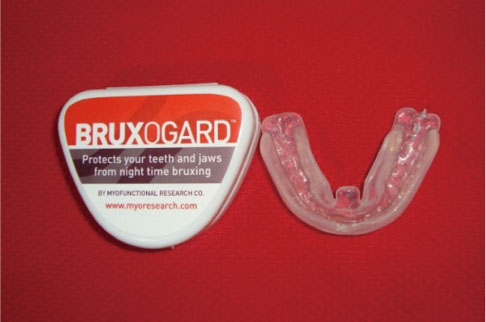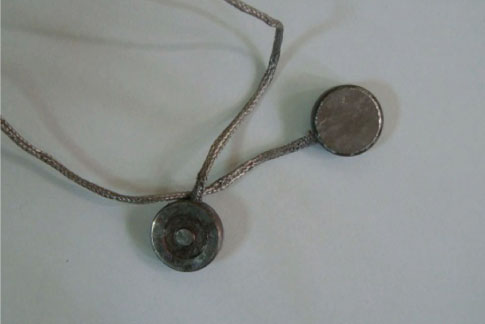J Adv Prosthodont.
2014 Apr;6(2):103-108. 10.4047/jap.2014.6.2.103.
Evaluation of the effect of two different occlusal splints on maximum occlusal force in patients with sleep bruxism: a pilot study
- Affiliations
-
- 1Department of Prosthodontics, Faculty of Dentistry, Gazi University, Ankara, Turkey. duygukoc@hotmail.edu.tr
- KMID: 2233337
- DOI: http://doi.org/10.4047/jap.2014.6.2.103
Abstract
- PURPOSE
The occlusal splint has been used for many years as an effective treatment of sleep bruxism. Several methods have been used to evaluate efficiency of the occlusal splints. However, the effect of the occlusal splints on occlusal force has not been clarified sufficiently. The purpose of this study was to evaluate the effect of occlusal splints on maximum occlusal force in patients with sleep bruxism and compare two type of splints that are Bruxogard-soft splint and canine protected hard stabilization splint.
MATERIALS AND METHODS
Twelve students with sleep bruxism were participated in the present study. All participants used two different occlusal splints during sleep for 6 weeks. Maximum occlusal force was measured with two miniature strain-gage transducers before, 3 and 6 weeks after insertion of occlusal splints. Clinical examination of temporomandibular disorders was performed for all individuals according to the Craniomandibular Index (CMI) before and 6 weeks after the insertion of splints. The changes in mean occlusal force before, 3 and 6 weeks after insertion of both splints were analysed with paired sample t-test. The Wilcoxon test was used for the comparison of the CMI values before and 6 weeks after the insertion of splints.
RESULTS
Participants using stabilization splints showed no statistically significant changes in occlusal force before, 3, and 6 weeks after insertion of splint (P>.05) and participants using Bruxogard-soft splint had statistically significant decreased occlusal force 6 weeks after insertion of splint (P<.05). There was statistically significant improvement in the CMI value of the participants in both of the splint groups (P<.05).
CONCLUSION
Participants who used Bruxogard-soft splint showed decreases in occlusal force 6 weeks after insertion of splint. The use of both splints led to a significant reduction in the clinical symptoms.
MeSH Terms
Figure
Reference
-
1. Cosme DC, Baldisserotto SM, Canabarro Sde A, Shinkai RS. Bruxism and voluntary maximal bite force in young dentate adults. Int J Prosthodont. 2005; 18:328–332.2. Harada T, Ichiki R, Tsukiyama Y, Koyano K. The effect of oral splint devices on sleep bruxism: a 6-week observation with an ambulatory electromyographic recording device. J Oral Rehabil. 2006; 33:482–488.3. Kurita H, Ikeda K, Kurashina K. Evaluation of the effect of a stabilization splint on occlusal force in patients with masticatory muscle disorders. J Oral Rehabil. 2000; 27:79–82.4. Roark AL, Glaros AG, O'Mahony AM. Effects of interocclusal appliances on EMG activity during parafunctional tooth contact. J Oral Rehabil. 2003; 30:573–577.5. Al-Saad M, Akeel RF. EMG and pain severity evaluation in patients with TMD using two different occlusal devices. Int J Prosthodont. 2001; 14:15–21.6. Hiyama S, Ono T, Ishiwata Y, Kato Y, Kuroda T. First night effect of an interocclusal appliance on nocturnal masticatory muscle activity. J Oral Rehabil. 2003; 30:139–145.7. Yap AU. Effects of stabilization appliances on nocturnal parafunctional activities in patients with and without signs of temporomandibular disorders. J Oral Rehabil. 1998; 25:64–68.8. Williamson EH, Lundquist DO. Anterior guidance: its effect on electromyographic activity of the temporal and masseter muscles. J Prosthet Dent. 1983; 49:816–823.9. Fitins D, Sheikholeslam A. Effect of canine guidance of maxillary occlusal splint on level of activation of masticatory muscles. Swed Dent J. 1993; 17:235–241.10. Sheikholeslam A, Holmgren K, Riise C. Therapeutic effects of the plane occlusal splint on signs and symptoms of craniomandibular disorders in patients with nocturnal bruxism. J Oral Rehabil. 1993; 20:473–482.11. McCarroll RS, Naeije M, Kim YK, Hansson TL. Short-term effect of a stabilization splint on the asymmetry of submaximal masticatory muscle activity. J Oral Rehabil. 1989; 16:171–176.12. Okeson JP. The effects of hard and soft occlusal splints on nocturnal bruxism. J Am Dent Assoc. 1987; 114:788–791.13. Roark AL, Glaros AG, O'Mahony AM. Effects of interocclusal appliances on EMG activity during parafunctional tooth contact. J Oral Rehabil. 2003; 30:573–577.14. Holmgren K, Sheikholeslam A, Riise C. Effect of a full-arch maxillary occlusal splint on parafunctional activity during sleep in patients with nocturnal bruxism and signs and symptoms of craniomandibular disorders. J Prosthet Dent. 1993; 69:293–297.15. Zarb GA, Speck JE. The treatment of temporomandibular joint dysfunction: a retrospective study. J Prosthet Dent. 1977; 38:420–432.16. Dylina TJ. A common-sense approach to splint therapy. J Prosthet Dent. 2001; 86:539–545.17. Braun S, Bantleon HP, Hnat WP, Freudenthaler JW, Marcotte MR, Johnson BE. A study of bite force, part 1: Relationship to various physical characteristics. Angle Orthod. 1995; 65:367–372.18. Kogawa EM, Calderon PS, Lauris JR, Araujo CR, Conti PC. Evaluation of maximal bite force in temporomandibular disorders patients. J Oral Rehabil. 2006; 33:559–565.19. Lobbezoo F, van der Zaag J, van Selms MK, Hamburger HL, Naeije M. Principles for the management of bruxism. J Oral Rehabil. 2008; 35:509–523.20. Sheikholeslam A, Holmgren K, Riise C. A clinical and electromyographic study of the long-term effects of an occlusal splint on the temporal and masseter muscles in patients with functional disorders and nocturnal bruxism. J Oral Rehabil. 1986; 13:137–145.21. al-Quran FA, Lyons MF. The immediate effect of hard and soft splints on the EMG activity of the masseter and temporalis muscles. J Oral Rehabil. 1999; 26:559–563.22. Bonfante G, Ramos Júnior L, Bonfante EA. Restoration of canine guidance on an occlusal splint using amalgam: a clinical report. J Prosthet Dent. 2003; 90:420–423.23. Klasser GD, Greene CS. Oral appliances in the management of temporomandibular disorders. Oral Surg Oral Med Oral Pathol Oral Radiol Endod. 2009; 107:212–223.24. Wright E, Anderson G, Schulte J. A randomized clinical trial of intraoral soft splints and palliative treatment for masticatory muscle pain. J Orofac Pain. 1995; 9:192–199.25. Wright EF. Using soft splints in your dental practice. Gen Dent. 1999; 47:506–510.26. Giedrys-Leeper E. Night guards and occlusal splints. Dent Update. 1990; 17:325–329.27. Pettengill CA, Growney MR Jr, Schoff R, Kenworthy CR. A pilot study comparing the efficacy of hard and soft stabilizing appliances in treating patients with temporomandibular disorders. J Prosthet Dent. 1998; 79:165–168.28. Rompré PH, Daigle-Landry D, Guitard F, Montplaisir JY, Lavigne GJ. Identification of a sleep bruxism subgroup with a higher risk of pain. J Dent Res. 2007; 86:837–842.29. Fricton JR, Schiffman EL. Reliability of a craniomandibular index. J Dent Res. 1986; 65:1359–1364.30. Koc D, Dogan A, Bek B, Yucel M. Effects of increasing the jaw opening on the maximum bite force and electromyographic activities of jaw muscles. J Dent Sci. 2012; 7:14–19.31. Narita N, Funato M, Ishii T, Kamiya K, Matsumoto T. Effects of jaw clenching while wearing an occlusal splint on awareness of tiredness, bite force, and EEG power spectrum. J Prosthodont Res. 2009; 53:120–125.
- Full Text Links
- Actions
-
Cited
- CITED
-
- Close
- Share
- Similar articles
-
- Changes of bite force and dynamic functional occlusion analysis after occlusal stabilization splint therapy in sleep bruxism patients: a pilot study
- Clinical Decision Support Model to Predict Occlusal Force in Bruxism Patients
- Computerized analysis of occlusal contacts in bruxism patients treated with occlusal splint therapy
- Implant complications in bruxism patients
- Comparison of maximum occlusal forces on osseointegrated implant supported fixed prostheses and natural teeth




